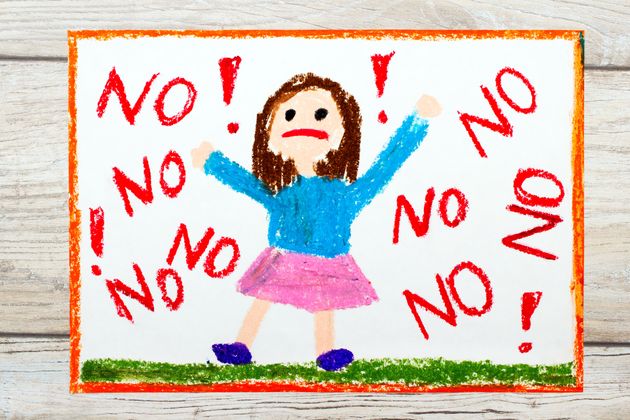No parent likes to discipline their child. It tends to be a tedious, loud, tantrum-y process and it’s just no fun.
Luckily, a new book from Lindsay Powers, the founding editor of Yahoo! Parenting, aims to make this whole parenting thing work best for parents of all stripes.
In “You Can’t F*ck Up Your Kids,” Powers writes that, well, you guessed it ― you can’t fuck up your kids. She tackles hot-button topics, from crying it out to picky eating, screen time to child care preferences.
Below is an excerpt on discipline from her book, out soon. As part of this chapter, Powers essentially makes the case that discipline is about shaping your kids into the kind of citizens you want to see more of in the world. If that’s not something we need now, then what is?
Continue reading below for the “game” Powers recommends to turn discipline into something a lot less scary and a lot more proactive.

“Discipline usually means punishment, but that should be recast,” says Dr. Alan E. Kazdin, a founder of the Yale Parenting Center and professor of psychology and child psychiatry there. Kazdin has worked with severely aggressive and antisocial children—and families facing everyday issues. His methods are simple—no traveling to Yale or spending big bucks to try them.
First, he asks parents to ask ourselves, “What are the three or four characteristics I want my children to have?” (If you are married or partnered, you should do this exercise together.) For example, how about raising an honest kid? Then first of all, we need to model honest behavior. Then, we need to watch for instances of our child acting honest. When we see an example of that, point it out. That immediately reinforces the behavior and development of the trait as the kid grows up.
Now, Kazdin jokes that this “doesn’t work fast enough” when our kids are losing it in front of an ice cream truck. So he recommends a “tantrum game”— which sounds ridiculous at first, but makes sense. He swears you can do it with kids as young as one and a half years old.
When you’re at home and everyone is feeling calm, tell your kid that he or she is going to have a pretend tantrum. “Here’s how it works: I’m going to tell you that you can’t do something, but you really can. It’s just pretend. When you have a tantrum, you’re going to get mad, but you’re not going to hit Mommy, and you’ll get a point on this chart.” (The point of having a tantrum chart? “The parents do better if we have a point system,” Kazdin jokes. So obviously feel free to ignore the chart, because I certainly do.) The next step: “Mom or Dad leans over and makes a mischievous smile. The smiling is important,” Kazdin explains, because it helps to set the tone that this is a “game.” It also helps parents feel calmer when their kid starts freaking out, even if it is a game.
Then you tell your kid, “You cannot watch TV tonight,” and watch him go nuts.

Now, it’s very important for parents to do three things, according to Kazdin. One: Offer very effusive praise. “Great! That was great! You got mad and you didn’t hit Mommy!” Next, you need to do something nonverbal, such as a high five, tap on the head, give a point. “Whatever works for your family,” Kazdin says. I like to squeeze my sons’ shoulders. Then the third step is to set up the behavior again, by saying something like, “That was great. I bet you can’t do two in a row. No five-year-old can do two in a row. Okay, let’s try another.”
Kazdin says tantrums disappear or greatly reduce themselves within one to three weeks of playing this game occasionally. Kids are getting praised for not acting as crazy when they’re upset. “What happens in the game can shape them,” he says. When a tantrum does happen, be sure to say something like, “We’re not even playing the game! That was fantastic!” Pretty soon, playing the “tantrum game” just dies out. “The parent gets a little loose, [the kid] gets praise, and it’s not a problem anymore,” Kazdin says. “I have done this thousands of times.” The key is introducing the antecedents, behaviors, and consequences (or, aptly, ABC).
We have to ask ourselves: How are we praising our kids when they’re doing something good? When my kids are quietly playing together, I used to be hesitant to say, “Wow! You guys are playing so well together. I’m so proud of you both,” because I was afraid that would snap them out of the moment and thus end my brief respite from wiping noses, butts, and tears.
But I’ve recently started spending a lot of time verbally praising what my kids are doing as they do it. And it’s working! Just this past weekend, Everett voluntarily let Otto play with a coveted train toy he got from a birthday party. And Otto shared his snack with Everett.
“The human mind has a negativity bias. We tend to leave them alone when they’re doing something good,” says Kazdin. Then when they’re acting up, we’re all over them—which actually has the opposite effect of nipping the behavior in the bud. We’re giving them attention for doing something bad, and they’re getting no attention for doing something good. So we’re basically reinforcing the bad behavior and undermining our attempts at punishment in the process.
From “YOU CAN’T F*CK UP YOUR KIDS: A Judgment-Free Guide to Stress-Free Parenting” by Lindsay Powers. Copyright © 2020 by Lindsay Powers. Reprinted by permission of Atria Books, a Division of Simon & Schuster, Inc.


